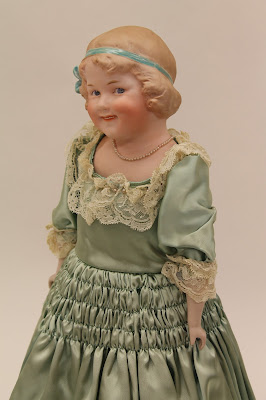2002 North Main Street
Santa Ana, California 92706
TEL: 714.567.3600
Gebrüder Heubach "Coquette" Doll
 |
|
Coquette Doll, c. 1903-1912
Made by Gebrüder Heubach, Germany
Bisque, satin, lace, and muslin; 21 in.
7893
Gift of E.P. Cutter
|


This “Coquette” bisque doll has been featured in four Bowers Museum exhibitions including the 1977 “Doll, a Nickname for Dorothy," the first major showing of the museum’s extensive doll collection from the 19th and 20th centuries and “36/86 - Golden Anniversary Exhibition” celebrating the Bowers' 50th anniversary. When this “Coquette” doll was created, it was stamped on the back with a stylized sunburst in a semi-circle, signifying this doll was made in Germany by Gebrüder Heubach, and “7850” signifying she is a “Coquette” model. This particular model is thought to have been produced between 1903 and 1912, during the era of the German brand’s characteristic trait of the "flirting eyes." The doll has blue intaglio eyes with the signature bisque head and shoulders. The body of the doll is made of muslin, and she is fashioned with a turquoise satin dress, two petticoats, pantalettes, and ecru lace trim. The doll also has bisque arms, hands and lower legs, along with shoes painted in a blue luster.
The “Coquette” doll is just one of over 250 dolls from the Irene Cutter Memorial Doll Collection at the Bowers Museum. The collection was generously donated by Irene’s husband, E.P. Cutter, in May of 1950 so that the doll collection could be displayed and enjoyed by all over the years.
All text and images under copyright. Please contact Collection Department for permission to use. Information subject to change upon further research.

Comments 1
I really enjoy reading your post. Thanks and keep sharing....